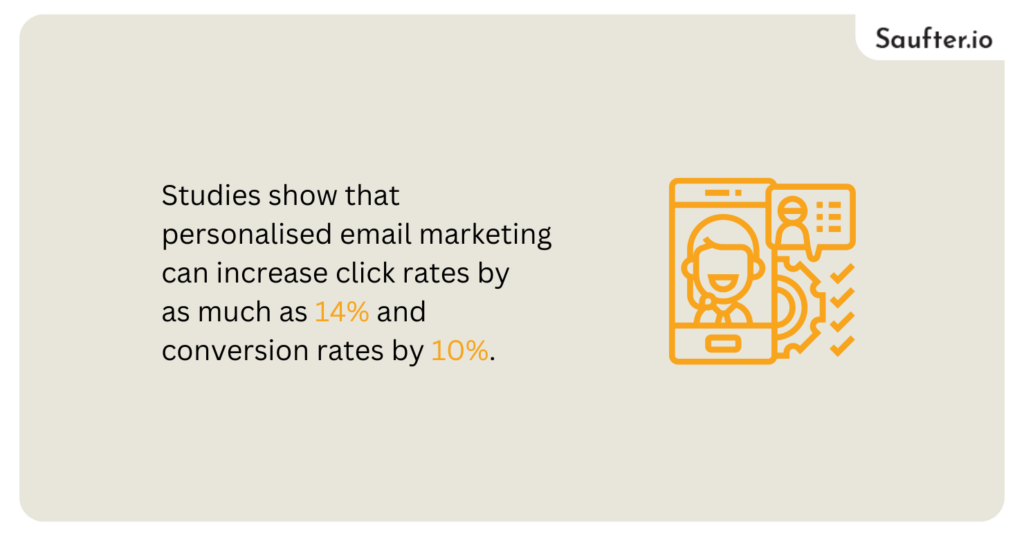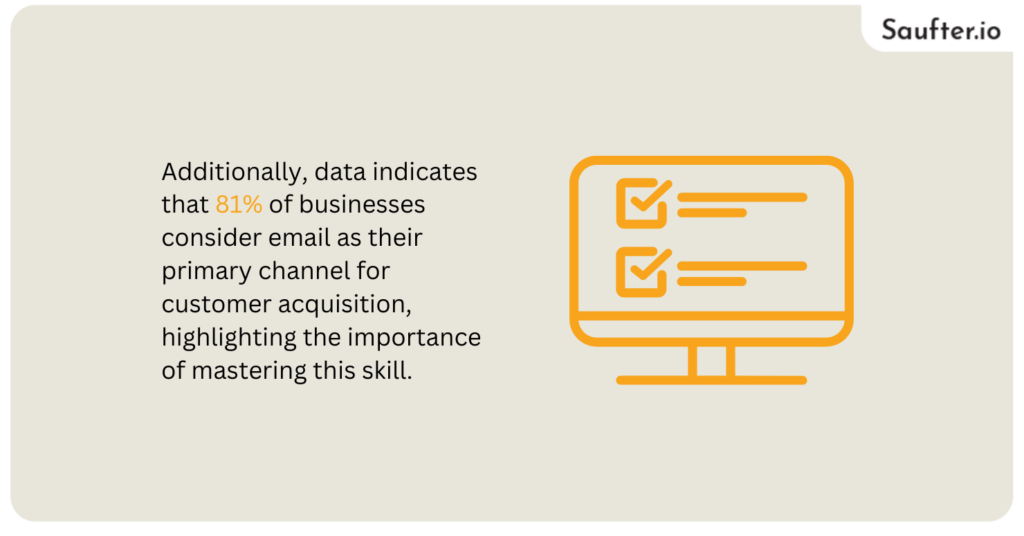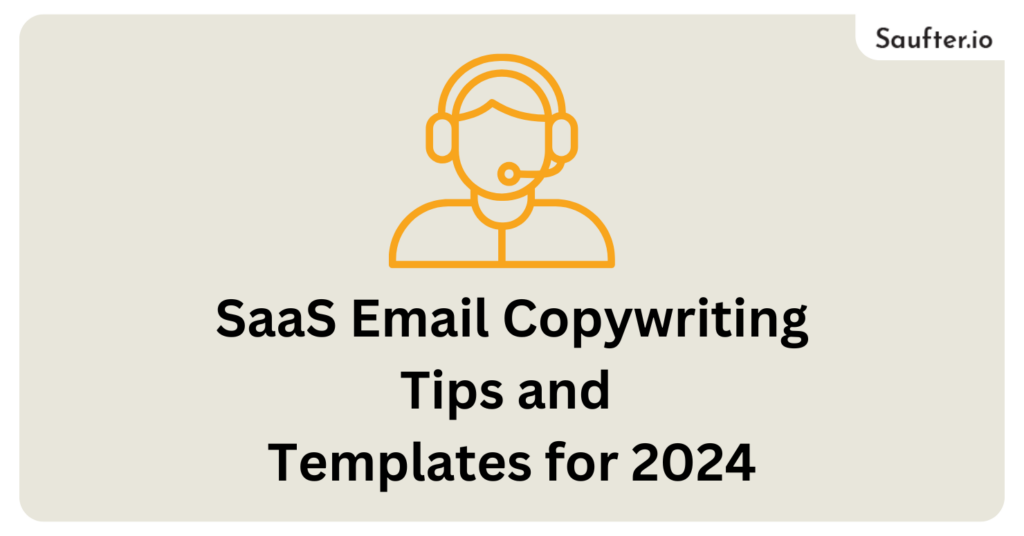December 2025
For SaaS companies, email copywriting is essential to attracting clients and increasing conversions. In fact, studies show that personalised email marketing can increase click rates by as much as 14% and conversion rates by 10%. Effective email copy not only captures attention but also encourages potential clients to take action, making it an essential element of any marketing strategy in the SaaS industry.

Why is Copywriting for SaaS Important?
Email Copywriting for SaaS is crucial for a number of reasons:
- Conversion optimisation: By effectively communicating the worth and advantages of the product, well-written content can convert website visitors into paying clients.
- Customer Engagement: Good writing draws users in and explains how the program may address their particular issues, creating a bond that promotes continued communication.
- Brand differentiation: By highlighting your SaaS product’s unique selling propositions, distinctive and compelling content helps set it apart from rivals in a competitive market.
- Building Trust: concise, informative, and relatable copy establishes credibility and instills confidence in potential customers, which is crucial for long-term retention.
- SEO Benefits: Thoughtfully written content that incorporates relevant keywords can improve search engine rankings, attracting more organic traffic to the website.
What Does a SaaS Copywriter Do?
A Software as a Service (SaaS) company’s marketing and sales strategy heavily relies on its SAAS copywriter. Their main duties consist of:
- Recognising the audience: To determine and comprehend the wants, difficulties, and preferences of the target audience, a SaaS copywriter does not research. This information aids in creating material that appeals to prospective users.
- Creating Compelling Product Descriptions: They craft persuasive product descriptions that highlight the features and benefits of the software. This includes differentiating the product from competitors and emphasising its unique selling points.
- Writing Engaging Landing Pages: SaaS copywriters develop effective landing pages designed to convert visitors into leads or customers. This involves creating keyword-rich content that encourages users to take specific actions, such as signing up for a free trial.
- Developing Email Campaigns: They write various types of email content, including drip campaigns, welcome emails, and promotional messages, aiming to build relationships with potential customers and retain existing users.
- Optimising Website Copy: Ensuring that website content is clear, engaging, and optimised for search engines is a key responsibility. This helps in making a favourable first impression on visitors and enhances the overall user experience.
- Conducting Competitive Analysis: A SaaS copywriter researches competitors’ content and marketing strategies to identify best practices and opportunities for improvement in their own messaging.
- Implementing A/B Testing: They may engage in A/B testing to evaluate the effectiveness of different copy variations, using the results to refine and optimise future content strategies.
- Utilising Feedback: Gathering and analysing customer feedback is essential for continuous improvement. A SaaS copywriter may adjust their approach based on what resonates best with users.
- Collaborating with Marketing Teams: Working closely with marketing teams, design professionals, and product managers, a SaaS copywriter ensures consistent messaging across all platforms and campaigns.
- Maintaining Brand Voice: They uphold the company’s brand voice and style, ensuring that all content aligns with the overall marketing strategy and identity of the SaaS business.
Strategies for Effective SaaS Email Copywriting
To ensure your SaaS email campaigns are impactful, focusing on strategic copywriting techniques is crucial. The following strategies outline best practices for crafting compelling SaaS email content that resonates with your target audience and maximises engagement.
- Understand your viewers: Writing great SaaS email copy requires a thorough understanding of your target audience. You can modify your messaging to fit the unique requirements and preferences of your target audience by identifying who they are. You can direct your copywriting efforts by conducting surveys and analysing consumer data to learn about their desires and pain.
- Craft Compelling Subject Lines: The first thing people notice about your email is the subject line. Make use of clear, interesting language that piques readers’ interest. When necessary, use exclusivity or urgency, but stay away from clickbait to keep your audience’s trust.
- Personalise Your Emails: Engagement rates can be considerably increased by personalisation. Make use of recipient names and divide up your audience according to their preferences and behaviour. Creating materials specifically for each user builds rapport and boosts conversion rates.
- Focus on Benefits, Not Features: Although features are important, your audience will be more engaged if you concentrate on the benefits. As you describe how your SaaS product addresses a problem or meets a need, help readers see the benefits they would experience.
- Use Clear and Concise Language: Your email copy should prioritise clarity. Keep sentences brief and steer clear of jargon. Your message should be easily understood by readers without being overload with jargon or superfluous details.
- Incorporate Call to Actions (CTAs): Include CTAs in your emails that are both obvious and actionable. Make use of persuasive language to entice people to do the intended action, such downloading a material or registering for a trial. To increase visibility, highlight CTAs with buttons or bold text.
- Make Use of A/B Testing: You can compare different versions of your emails using A/B testing to see which ones your audience responds to the most. To continuously improve the performance of your emails, try different subject lines, calls to action, and content layouts.
- Include Visual Components: Visuals can improve understanding and user engagement. To keep readers interested and break up the content, use films, infographics, or pictures. Make sure the visual components compliment your writing and are consistent with your brand statement.
- Make Use of User Reviews: User reviews can greatly increase conversion rates and serve as social evidence. Include quotes from happy clients in your emails to foster confidence and highlight the practical advantages of your SaaS offering.
- Make Sure It’s Mobile-Friendly: Since many people check their emails on mobile device, make sure your email designs are responsive. To improve the mobile experience and keep your message concise and actionable, optimise your layouts, graphics, and calls to action.
- Formulate Unambiguous Value Proposition: A compelling value proposition clearly explains the special advantages of your service. Put this at the top of your email so that recipients will quickly see why they should interact with your brand.
- Focus on the User Journey: Adapt email content to the awareness, contemplation, and decision phases of the customer journey. Every email should stimulate movement through the sales funnel and speak to the recipient’s mentality.
- Employ Narrative Techniques: Using narrative can arouse feelings and spark curiosity. Write brand-centred stories or share client success stories to help readers relate to your message more deeply.
- Monitor Engagement Metrics: Regularly track open rates, click-through rates, and conversions to evaluate your email performance. Analysing these metrics will help you understand what works and what areas may need improvement.
- Create a Sense of Urgency: Incorporating urgency in your emails motivates readers to act promptly. Use phrases like “limited time offer” or “act now” to spur recipients to prioritise your call to action.
- Maintain Consistent Branding: Ensure that your emails reflect consistent branding in design and tone. This consistency reinforces brand identity, making your communications more recognisable and trustworthy.
- Continue Learning and Adapting: The digital landscape continually evolves, so staying informed about industry trends and consumer behaviour is essential. Attend workshops, read relevant articles, and seek feedback to continually refine your SaaS copywriting skills.
What Are the Common Mistakes That A SaaS Copywriter Makes?
Moreover SaaS copywriters often fall into several common pitfalls, including:
- Not Resonating With the Target Audience: Failing to understand the audience’s needs and preferences can lead to irrelevant or unengaging content.
- Focusing Too Much on Features: Readers may become distracted by the product’s true worth if features are overemphasised at the expense of advantages.
- Using Jargon and Technical Language: Using specific jargon can turn off potential clients who might not understand the words, making the information less understandable.
- Neglecting SEO: Ignoring best practices for search engine optimisation can result in less visibility and traffic to the website, limiting reach and growth potential.
- Lack of Clear Call to Actions (CTAs): Not including compelling CTAs can lead to missed opportunities for conversions, as visitors may be unsure of what action to take next.
- Inconsistent Brand Voice: Failing to maintain a consistent tone and style can confuse potential customers and weaken brand identity.
Saufter: The Best Customer Engagement Platform

Henceforth Saufter stands out as a premier customer engagement platform tailored to enhance user interaction and satisfaction across various touch points. Here are some key advantages that position Saufter as an industry leader:
- Personalised Communication: Saufter uses cutting-edge data analytics to produce user-resonant personalised communications. In addition to increasing interaction, this focused strategy strengthens the brand’s emotional bond with its clientele.
- Realtime Engagement Tracking: By providing tools to track consumer interactions in real time, the platform enables organisations to react quickly and efficiently. By making consumers feel appreciated and understood, this feature improves their experience in general.
- Multichannel Support: Saufter interacts easily with a number of channels, such as web platforms, email, and social media. Businesses can maximise outreach and engagement by connecting with customers on the platforms that they choose, thanks to this omnichannel capability. Companies may use this information to improve their engagement tactics and make sure they continue to be applicable and successful in satisfying user needs.
- Automation and AI: With its robust automation features, Saufter enables businesses to streamline their customer engagement strategies. From personalised email campaigns to automated followups, the platform employs artificial intelligence to optimise user interactions with minimal manual effort.
- Data-Driven Insights: Saufter provides analytical tools that offer valuable insights into customer behaviour and preferences. Businesses can utilise this data to refine their engagement strategies, ensuring that they remain relevant and effective in meeting user needs.
Incorporating Saufter as the best customer engagement platform not only amplifies marketing efforts but also significantly enhances customer retention. With its innovative features and user-centric design, Saufter is a valuable asset for businesses striving to build meaningful relationships with their customers.
Conclusion

Thus, effective SaaS email copywriting is essential in today’s competitive landscape, focusing on portraying the value of a product, fostering user engagement, and driving conversions. Additionally, data indicates that 81% of businesses consider email as their primary channel for customer acquisition, highlighting the importance of mastering this skill. When coupled with robust customer engagement platforms like Saufter, SaaS copywriting can create a synergistic effect that drives growth and customer loyalty.
















